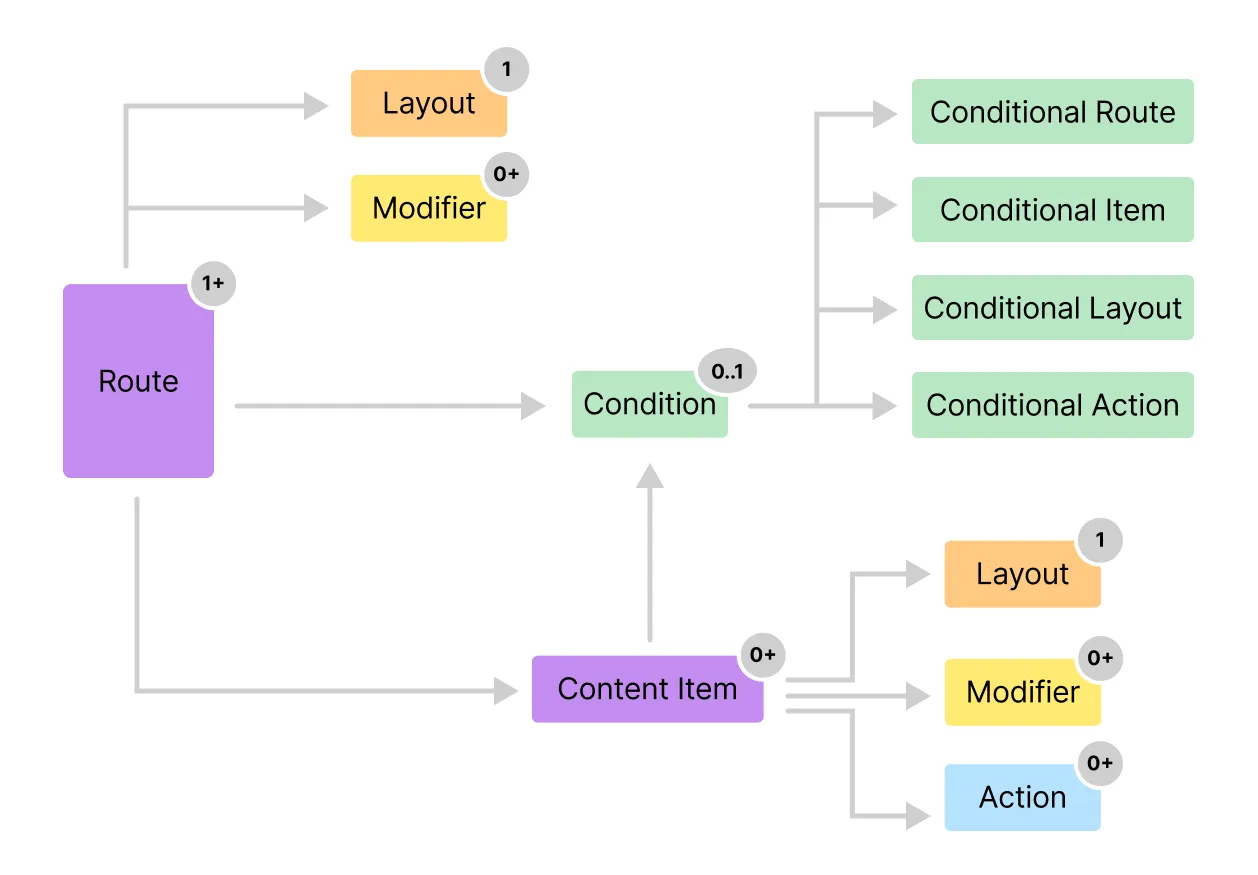Core Elements
Applications have become much more sophisticated in the past few years and will continue to advance the State of the Art. Many of them are moving into the realm of being content-oriented, server-driven experiences. It is in this category that we would like to play as a framework.
In this article let’s explore the five core elements of building such experiences. This is a distilled version of the essentials for any App and are the fundamental building blocks of a CMS-driven experience. These 6 elements are:
- Route
- Content Item
- Layout
- Modifiers New
- Action
- Condition

Let’s see each of these in more detail.
A route represents a single page of content. This could mean a screen in case of
an App or a page in case of a Website. It is a logical container that has fixed
identity (with the path attribute) and could become part of a User
journey. A journey is where you string a collection of routes in a fixed order
to accomplish some goal.
Routes are a container of content, which are represented by one or more of the Content Item building block. When building an App Experience, you would start from a Route as your starting point, give it a path and the assemble the set of content-items that represent the content of the page or screen.
Conditional Route
Section titled “Conditional Route”Routes can also have a condition, which makes them have one or more destinations depending on the runtime-evaluation of the condition. A good example is the Login page of an App. If you are not already logged in, this page is shown with the login controls. If you are already logged in, you could be shown or redirected to the Home page. Here the condition is the logged-in state of the user. You could build the login page as a conditional-route and have it automatically show the right page depending on the runtime condition.
Content Item
Section titled “Content Item”This is possibly the most important building block of any App. Without this there would be nothing to show to the user. The content item represents the real information that the user wants to see or act upon. This could be a set of products that is shown in a list or a video or the payment-form during checkout.
There is a wide range of content-items you can have and many will be custom and unique to your application. There are several built-in content items such as Card, Group, Accordion, Divider, Video, etc. However, the framework is also built for extending this list with your own custom ones.
Route is a Content Item
Note that a Route is also a specialized form of a Content Item. It just happens to be a container but really a sub type of a Content Item. Hence, almost everything that applies to a Content Item, also applies to a Route.
API Content
Section titled “API Content”One of the commonly used content items is the API Content. This represents a self-contained way of rendering network content. It takes a configuration that allows you to connect to any third-party API and use that data to render a Flutter Widget.
For example, you can have an API Configuration that talks to Firebase or Supabase or a specific enterprise API to fetch data and render it in a Widget. You can also show its loading and error states, if need be.
Layout
Section titled “Layout”The appearance of a Content Item is controlled by its Layout. In fact, there can be multiple layouts for a Content Item. However, only one of them is applied at a time. The ability to have multiple layouts is what makes the framework so powerful. You could switch these layouts for different content items for different pages. So, the same item can appear differently under different contexts.
You would have seen this already in scenarios where a Product-item appears in a mini-view for a Search listing page and then an expanded view in the detail page. This is purely a layout change for the same Product content-item.
Default Layout
Every Content Item has a default layout, which is used when there is none specified on the CMS.
Modifiers New
Section titled “Modifiers ”Modifiers are additional visual behaviors that can be attached to the output of the layout in order to produce something interesting. This could change the theme of the contained widget, provide more localization context, or do things like in coach marks.
Modifiers are an interesting way of extending the visual behaviors of the layout without having to write all of those behaviors for each specific content item.
The input to a modifier is the built Widget of the content item, which is then
optionally wrapped in a Widget by each modifier in order to produce the final
output.
Thus, the output of a modifier is also a Widget. For modifiers that don’t make
any change, it is very natural to return the same widget that was passed in.
This could be the case of a simple pass-through modifier. Other modifiers can do
a wrapping of additional providers or InheritedWidgets to provide additional
context for the contained widget
You can have multiple modifiers applied to a single content item. This allows you to build complex visual behaviors by composing and chaining simpler ones. The order is particularly important as the output of one modifier is the input to the next.
As expected, you can configure all modifiers in the CMS.
Action
Section titled “Action”Actions allow the user to participate and interact with the interface. There can be a variety of actions that can be invoked in response to User events (tap, swipe, scroll) and also system events (eg: Network response, timers, etc.). The most popular action that you will being used is the Navigation Action. This allows a user to go from Route to Route and navigate a user-journey. As you can expect, the framework has several built-in actions such as:
- Navigation
- Show/hide snack bars
- Show/hide drawers
- Open URL
- Open Dialog
- Toggle Light/Dark theme
- Show Alerts
As expected, you have the ability to create custom actions and do things very specific to your application.
Condition
Section titled “Condition”A condition is a runtime evaluation of some criteria which results in a set of
defined values. For example, the simplest condition could evaluate to a true
or false. A subscription-status condition could result in none, standard,
or premium.
Conditions can be applied to all of the building blocks seen earlier: Route, Content Item, Action and Layout. This gives a unique super power to branch on a condition and show a different route, content-item or layout, or take a different action.
Some of the common conditions have been built into the system such as:
- A simple Boolean condition
- Current theme
- Feature Flag
- Current Screen Size
- Current platform
- User Authentication status
Of course, you are free to extend this set by creating custom conditions.
Summary
Section titled “Summary”Route, Content Item, Layout, Action and Condition are the core elements that can be combined in creative ways to pretty much create any Application you can imagine. It might seem a bit too simplistic at first. However, it will grow on you and you will start decomposing complex problems into one or more of these elements.
As a matter of fact, why don’t you try it out on the Payment journey in an app :thinking:.

